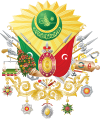Nilüfer Hatun
| Nilüfer Hatun | |
|---|---|
 | |
| Valide Hatun of the Ottoman Empire | |
| Tenure | March 1362 – 1363 |
| Successor | Gülçiçek Hatun |
| Died | c. 1363 Bursa, Ottoman Sultanate |
| Burial | Orhan Gazi Tomb, Bursa |
| Consort | Orhan |
| Issue | Murad I |
| Dynasty | Ottoman |
| Religion | Orthodox Christian (birth) Sunni Islam (conversion) |
Nilüfer Hatun (Ottoman Turkish: نیلوفر خاتون, water lily, called also Lülüfer Hatun or Ülüfer Hatun, died c.1363[1]), was a concubine of Orhan, the second Ottoman sultan, and the mother of Murad I, Orhan's successor. She was the first slave of Christian origin to become the mother of an Ottoman Sultan.
Biography
[edit]Nilüfer Hatun was an enslaved concubine of Greek origins, who entered Orhan's harem in 1325. The following year, she bore Orhan a son, the future Murad I.[2][3][4] After 1331, she was transferred to Iznik together with her son.[4]
In March 1362, Orhan died and was succeeded as sultan by Nilüfer's son, Murad I. Nilüfer, thus, became the first woman of Christian slave origins to be the mother of an Ottoman sultan and the first Valide Hatun of the Ottoman Empire.[4][5][6]
During her lifetime, Nilüfer commissioned the construction of an imaret, an hammam, a caravanserai and eighteen other buildings for various uses, especially charitable.[4]
The date of Nilüfer's death is not known with certainty and is variously estimated between 1363[1] and 1383.[4][6] She died in Bursa and was buried in the same city, in the Orhan's türbe.[3][4][6]
In 1388, Murad I commissioned the construction of the Nilüfer Hatun Imaret, at Iznik, dedicated to his mother's memory and financed by her waqf inheritance. Originally a convent for dervishes, it was restored in 1950 and opened to the public in 1960 as the Iznik Museum.[7]
Issue
[edit]By Orhan, Nilüfer had two sons and a daughter:[2][3][4]
- Murad I (1326-1389). Sultan of the Ottoman Empire after his father.
- Kasım Bey (C.1328-C.1346)
- Hatice Hatun - She married Süleyman Bey, Son of Saru Batu Savcı Bey and cousin of Orhan. They had two sons, Hamza Bey (who had a son, Mehmed Bey) and Mustafa Bey (who had a son, Osman Bey), as well as, two daughters, Ilaldi Hatun and Fatma Hatun.
Historical controversies
[edit]The traditional narrative on Nilüfer is extremely confusing and conflicting because, being the mother of a reigning sultan but of slave origins, subsequent historians took care to "ennoble" her, attributing origins and stories to her that were actually fictitious or concerning other consorts of Orhan, a process involving several Ottoman consorts over the centuries.[3]
An example of this is the way in which Nilüfer was described as a Byzantine noblewoman named Holofira, daughter of the tekfur of Bilecik,[4][6] a narrative that actually merges the stories of the Orhan's consorts Bayalun and Asporça: in fact, the abduction of Bilecik's daughter occurred in 1299, more than twenty years before Nilüfer's entry into the harem.[2][3][4][8][9][10] Likewise, tradition wrote that Nilüfer was the consort of Orhan whom ibn Battuta met in Bursa in 1331, while this woman was, again, Bayalun or Asporça.[3][11][12]
An other example is the fact that tradition attributed to Nilüfer the motherhood of Süleyman (1306-1357), the eldest and favorite of Orhan's sons and his presumptive heir until his death in 1357, in a hunting accident. In reality, Süleyman was the son of the consort Efendize Hatun and was born in 1306, twenty years before the appearance of Nilüfer in the harem and the birth of Murad I.[3][4]
See also
[edit]- Ottoman Empire
- Ottoman family tree
- Ottoman dynasty
- Line of succession to the Ottoman throne
- Ottoman Emperors family tree (simplified)
- List of the mothers of the Ottoman Sultans
- List of consorts of the Ottoman Sultans
Notes and references
[edit]- ^ a b Pazan, İbrahim (2007). "Nilüfer Hatun". Padişah anneleri (in Turkish). Babıali Kültür Yayıncılığı. ISBN 978-9944-118-31-6.
- ^ a b c Alderson, Anthony Dolphin (1956). The Structure of the Ottoman Dynasty. Clarendon Press. pp. 83, 165 n4.
- ^ a b c d e f g Peirce, Leslie P. (1993). The Imperial Harem: Women and Sovereignty in the Ottoman Empire. Oxford University Press. pp. 33–35. ISBN 978-0-19-508677-5.
- ^ a b c d e f g h i j "NİLÜFER HATUN". TDV İslâm Ansiklopedisi (in Turkish). Retrieved 2024-05-08.
- ^ "VÂLİDE SULTAN". TDV İslâm Ansiklopedisi (in Turkish). Retrieved 2024-05-08.
- ^ a b c d www.akademya.biz. sicill-i.osmani (in Turkish). p. 32.
- ^ "NİLÜFER HATUN İMARETİ". TDV İslâm Ansiklopedisi (in Turkish). Retrieved 2024-05-08.
- ^ Aşıkpaşazade (2008). Âşık Paşâzade tarihi (in Turkish). Mostar. p. 54. ISBN 978-605-101-018-2.
- ^ Lowry, Heath W. (2012-02-01). The Nature of the Early Ottoman State [153]. State University of New York Press. ISBN 978-0-7914-8726-6.
- ^ Goodwin, Godfrey (2006). The Private World of Ottoman Women [32]. Saqi. ISBN 978-0-86356-745-2.
- ^ Alderson, p.165
- ^ Sakaoğlu, Necdet (2008). Bu mülkün kadın sultanları: vâlide sultanlar, hâtunlar, hasekiler, kadınefendiler, sultanefendiler (in Turkish). Oğlak Yayıncılık. pp. 38–40. ISBN 978-975-329-623-6.
Further reading
[edit]- Yavuz Bahadıroğlu, Resimli Osmanlı Tarihi, Nesil Yayınları (Ottoman History with Illustrations, Nesil Publications), 15th Ed., 2009, ISBN 978-975-269-299-2 (Hardcover).
- 14th-century consorts of Ottoman sultans
- 14th-century women from the Ottoman Empire
- Converts to Sunni Islam from Eastern Orthodoxy
- Former Greek Orthodox Christians
- People from the Ottoman Empire of Greek descent
- Concubines of Ottoman sultans
- 14th-century slaves
- Valide hatuns
- Slaves from the Ottoman Empire
- 14th-century slaves from the Ottoman Empire

